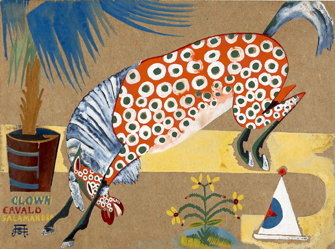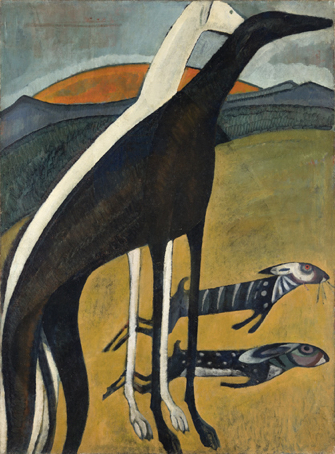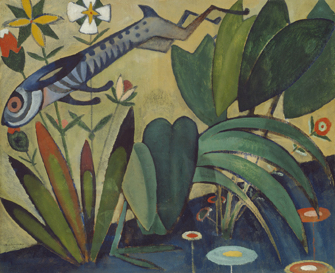Life Cut Short,
Career Resurrected

“Titre Inconnu (Clown, Cheval, Salamandre)” (c. 1911-12). Lisbon, CAM/Fundação Calouste Gulbenkian. Photo: Paulo Costa
I was alerted to the exhibition “Amadeo de Souza-Cardoso” at the Grand Palais by a friend in Portugal, who wrote to say that I must see this retrospective of the work of his favorite artist. It was a good tip.
This is something of a tragic story, since this handsome, brilliant and prolific young artist, born in 1887, died of the Spanish flu in 1918, when he was barely 30 years old, and was then more or less forgotten.
He managed to pack a lot of life and work into that short span, however. The child of wealthy landowners in Manhufe, in northern Portugal, he lived in Paris between 1906 and 1914, when he moved back to Portugal at the beginning of World War I. While in Paris, he was exposed to many of the movements of the time – among them Cubism, Fauvism, and Futurism – and befriended a number of artists who influenced his work, among them Amedeo Modigliani, Constantin Brancusi, and Sonia and Robert Delaunay.
With Modigliani, he shared not only a first name, but also rugged good looks. In Paris, he was a dashing Bohemian dandy on the Montparnasse scene, dressed to the nines, with a touch of eccentricity – a Spanish cape, for example, or a toreador’s cap.
While he was no penniless artist living in a garret – he received a generous monthly stipend from his father – he was no dilettante either. He assiduously attended artists’ workshops and produced hundreds of paintings and many more works on paper. Although he was obviously soaking up all the influences he encountered in Paris, where he exhibited at the Salon des Indépendants and the Salon d’Automne, Souza-Cardoso denied being a follower of any movement. “I don’t belong to any school,” he said in an interview in 1916. “Schools are dead. Those of us who belong to the new generation are interested only in originality. Impressionist, Cubist, Futurist, Abstractionist? A little of everything.”
The show includes some 300 works in all. Those I found most appealing were the paintings made around 1911, which have a kind

“Lévriers” (c. 1911). Lisbon, CAM/Fundação Calouste Gulbenkian. Photo: Paulo Costa
of naive sophistication and immense charm, among them “Levriers,” “Clown, Cheval, Salamandre” and “Le Saut du Lapin,” (all pictured on this page), before the artist moved

“Le Saut du Lapin” (1911). © The Art Institute of Chicago
into his more Cubist and folkloric phases. I also loved the India-ink drawings he made for the album “XX Dessins.”
On leaving the exhibition, visitors are left with a strong impression of an exuberant explosion

“Titre Inconnu (McCall’s)” (c. 1917-18). Photo: Paulo Costa
of color. One can only wonder, sadly, what direction the artist would have taken in his work had he been able to live a full life.
Galeries Nationales du Grand Palais: 3, avenue du Général Eisenhower, 75008 Paris. Métro: Champs-Elysées Clemenceau. Tel.: 01 44 13 17 17. Open Wednesday, 10am-10pm, Thursday-Monday, 10am-8pm. Closed Tuesday. Admission: €13. Through July 18, 2016. www.grandpalais.fr
Reader reaction: Click here to respond to this article (your response may be published on this page and is subject to editing).
More reviews of Paris art shows.
© 2016 Paris Update
Favorite